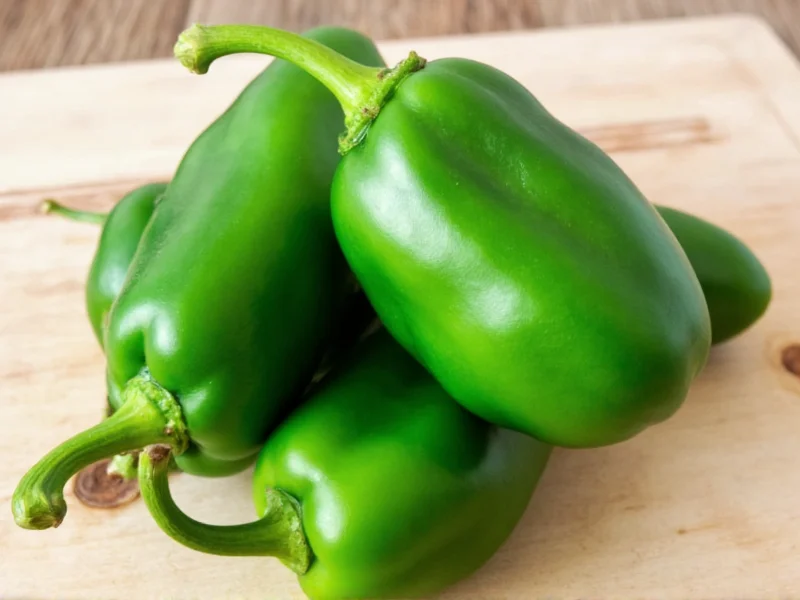Visual Identification Guide for Poblano Peppers
When searching for a pic of poblano pepper, you're likely trying to distinguish this versatile chili from other common varieties. Understanding what a poblano looks like is essential for both home cooks and gardening enthusiasts. This guide provides comprehensive visual identification details with practical information about this popular Mexican chili.
Key Physical Characteristics
The poblano pepper (Capiscum annuum) has several distinctive features that help with identification. When selecting fresh poblano peppers at your local market, look for these characteristics:
| Characteristic | Description |
|---|---|
| Size | 4-6 inches long, 2-3 inches wide at the shoulder |
| Shape | Heart-shaped with a rounded bottom and tapered top |
| Color (immature) | Deep, dark green |
| Color (mature) | Bright red to deep burgundy |
| Surface texture | Smooth with occasional shallow wrinkles |
| Stem | Thick, sturdy stem attached to the shoulder |
| Heat level | Mild to medium (1,000-2,000 Scoville Heat Units) |
What Does a Poblano Pepper Look Like?
When examining a fresh poblano pepper image, you'll notice its distinctive heart-shaped profile. The pepper has a broad, rounded base that tapers toward the stem end, creating a characteristic silhouette. The skin is relatively thick compared to bell peppers but thinner than some other chili varieties.
Immature poblano peppers are consistently dark green, almost black in some lighting conditions. As they mature on the plant, they transition through shades of green to a vibrant red, then deepen to a rich burgundy. This color transformation is important for understanding the difference between fresh poblanos and dried anchos (dried red poblanos).
Distinguishing Poblano Peppers from Similar Varieties
Many shoppers confuse poblano peppers with other common chili varieties. Here's how to tell them apart when viewing a pic of poblano pepper versus similar options:
Poblano vs Bell Pepper
While both have a somewhat similar shape, bell peppers typically have four lobes at the base and come in multiple colors (green, red, yellow, orange). Poblanos have a more pronounced heart shape with three lobes, thinner walls, and contain seeds with noticeable heat. Bell peppers have zero Scoville units while poblanos offer mild heat.
Poblano vs Jalapeño
Jalapeños are significantly smaller (2-3 inches long), cylindrical, and have a smoother, shinier skin. They range from bright green to red but maintain their slender shape. Poblanos are larger, heart-shaped, and have a more matte finish to their skin.
Poblano vs Anaheim
Anaheim peppers are longer and narrower (6-7 inches) with a more tapered shape throughout. They have thinner walls and are generally milder than poblanos. While both start green, Anaheim peppers turn a brighter red when mature compared to the deeper burgundy of mature poblanos.
Common Uses for Poblano Peppers
Understanding what a poblano pepper looks like helps you select the right ingredient for various culinary applications. These versatile peppers feature prominently in Mexican cuisine:
- Chiles Rellenos - The classic dish where poblano peppers are stuffed with cheese, battered, and fried
- Rajas con Crema - Sliced roasted poblano peppers in a creamy sauce
- Mole - Dried red poblanos (anchos) form the base of many mole sauces
- Guacamole - Finely diced raw poblano adds mild heat to guacamole
- Roasted Poblano Soup - A creamy soup highlighting the pepper's flavor
Fresh vs Dried Poblano Peppers
When searching for a poblano pepper picture, it's important to understand the difference between fresh and dried forms:
Fresh poblano peppers are the green or red versions you find in the produce section. When allowed to fully ripen to red and then dried, they become known as ancho peppers. Anchos have a raisin-like sweetness with notes of tobacco and coffee, making them essential for authentic mole sauces.
The drying process dramatically changes both appearance and flavor. Fresh poblanos have taut, smooth skin while anchos appear wrinkled and leathery. The color transforms from vibrant red to a deep, matte burgundy.
Where to Find Poblano Peppers
Poblano peppers are widely available in most grocery stores, particularly those with well-stocked produce sections. Look for them year-round in:
- Major supermarket chains (typically in the specialty pepper section)
- Mexican grocery stores (often labeled as "poblanos" or "chiles poblanos")
- Farmers markets (especially during summer and early fall)
- Gourmet food stores
When selecting fresh poblanos, choose peppers that feel heavy for their size with firm, unblemished skin. Avoid those with soft spots, wrinkles, or discoloration. Store them in the refrigerator's crisper drawer for up to two weeks.
Growing Poblano Peppers
For gardening enthusiasts searching for a poblano pepper photo to identify their plants, these peppers grow on compact bushes reaching 2-3 feet tall. The plants produce white flowers that develop into the characteristic heart-shaped peppers. Poblano plants require 65-80 days to maturity from transplanting and prefer warm temperatures with consistent moisture.
When growing poblanos, remember they change color as they mature. Most are harvested while still green, but allowing them to ripen to red increases their sweetness and transforms them into anchos when dried.











 浙公网安备
33010002000092号
浙公网安备
33010002000092号 浙B2-20120091-4
浙B2-20120091-4